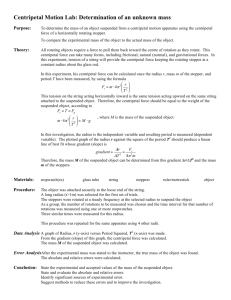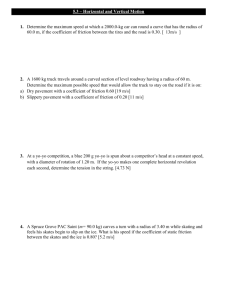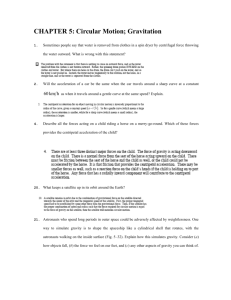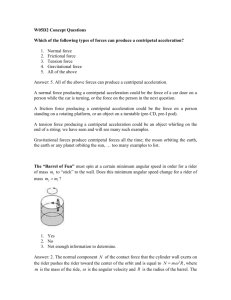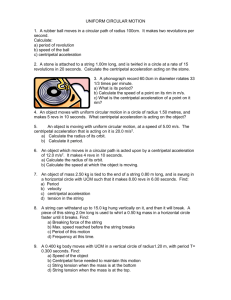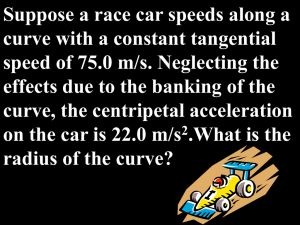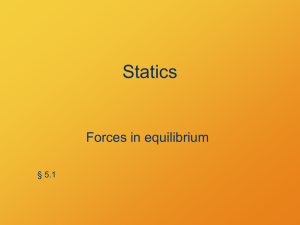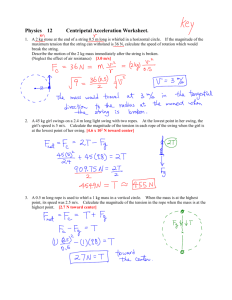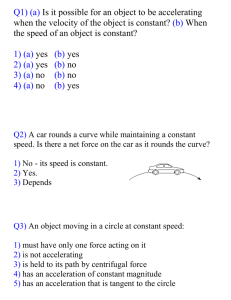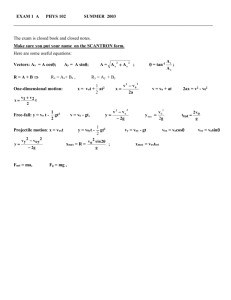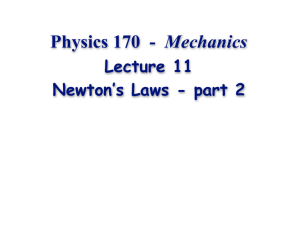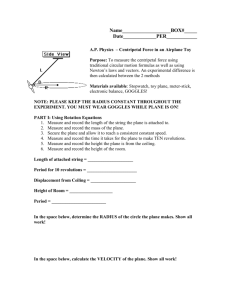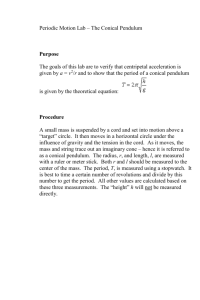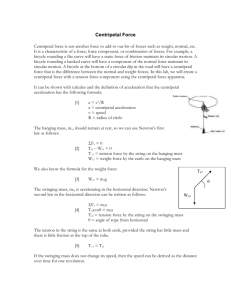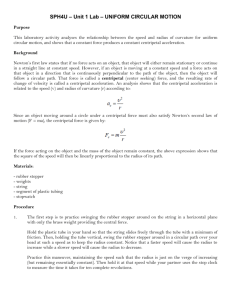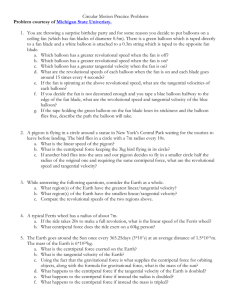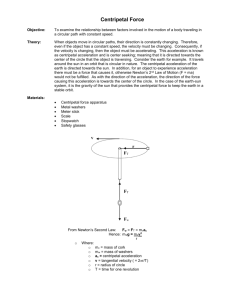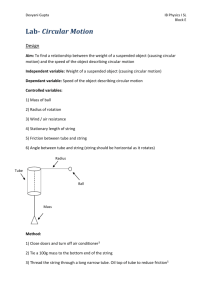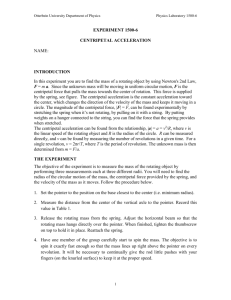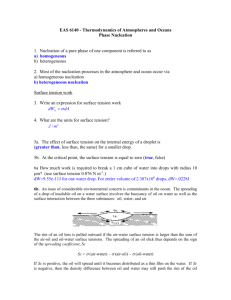Extra UCM Questions
advertisement
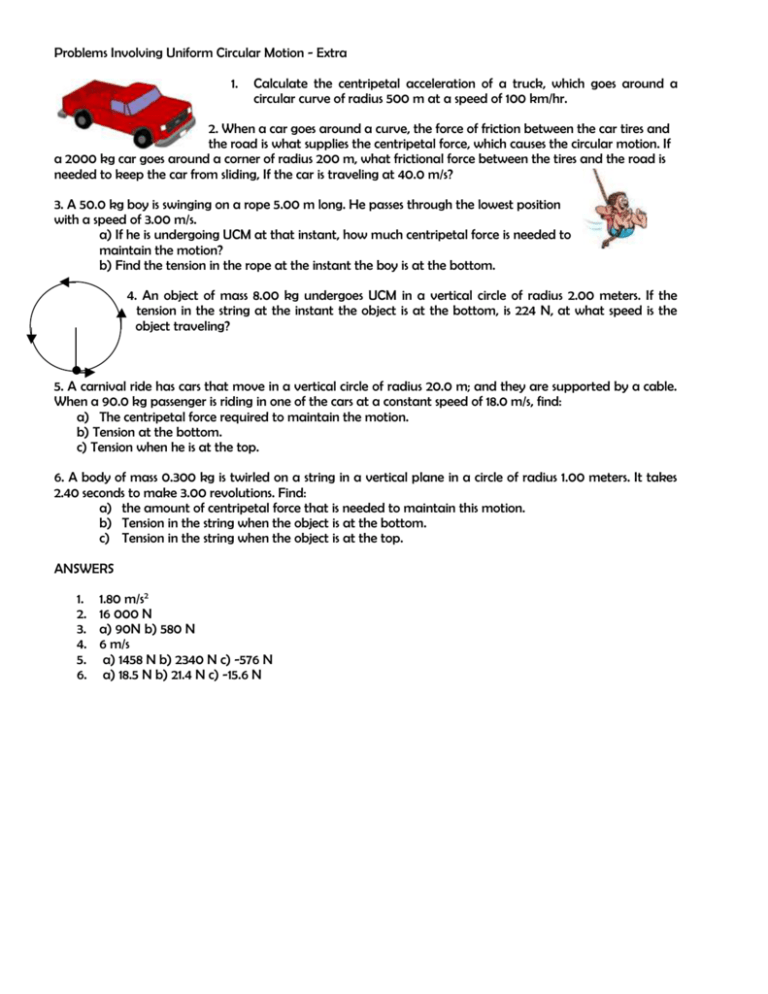
Problems Involving Uniform Circular Motion - Extra 1. Calculate the centripetal acceleration of a truck, which goes around a circular curve of radius 500 m at a speed of 100 km/hr. 2. When a car goes around a curve, the force of friction between the car tires and the road is what supplies the centripetal force, which causes the circular motion. If a 2000 kg car goes around a corner of radius 200 m, what frictional force between the tires and the road is needed to keep the car from sliding, If the car is traveling at 40.0 m/s? 3. A 50.0 kg boy is swinging on a rope 5.00 m long. He passes through the lowest position with a speed of 3.00 m/s. a) If he is undergoing UCM at that instant, how much centripetal force is needed to maintain the motion? b) Find the tension in the rope at the instant the boy is at the bottom. 4. An object of mass 8.00 kg undergoes UCM in a vertical circle of radius 2.00 meters. If the tension in the string at the instant the object is at the bottom, is 224 N, at what speed is the object traveling? 5. A carnival ride has cars that move in a vertical circle of radius 20.0 m; and they are supported by a cable. When a 90.0 kg passenger is riding in one of the cars at a constant speed of 18.0 m/s, find: a) The centripetal force required to maintain the motion. b) Tension at the bottom. c) Tension when he is at the top. 6. A body of mass 0.300 kg is twirled on a string in a vertical plane in a circle of radius 1.00 meters. It takes 2.40 seconds to make 3.00 revolutions. Find: a) the amount of centripetal force that is needed to maintain this motion. b) Tension in the string when the object is at the bottom. c) Tension in the string when the object is at the top. ANSWERS 1. 2. 3. 4. 5. 6. 1.80 m/s2 16 000 N a) 90N b) 580 N 6 m/s a) 1458 N b) 2340 N c) -576 N a) 18.5 N b) 21.4 N c) -15.6 N CIRCULAR MOTION 1. A bicycle with 68 cm diameter tires, travels 2.0 km. How many revolutions do the wheels make? 2. A jet plane traveling at 1800 km/hr pulls out of a dive by moving in an arc of 3.0 km radius. What is the plane's acceleration? 3. Calculate the centripetal acceleration of the earth in its orbit around the sun and the net force exerted on it. (Ro = 1.5 x 108 km Me = 5.98 X 1024 kg) 4. A clock has a second hand that is 40.0 cm long. Calculate the acceleration of the tip of the hand. 5. A 300.0 g mass on the end of an 80.0 cm string is whirled in a vertical plane at a constant speed with a period of 1.5 s. What is the greatest and least tension exerted by the string? 6. A rope can just support a 150 N weight without breaking. At what speed can this rope be used to whirl a 3.0 kg mass in a horizontal circle of 2.0 m radius? 7. A 30.0 kg boy is swinging on a rope 7.0 m long. He passes through the lowest position at 300.0 cm/s. What is the tension in the rope at this moment? 1300 m 300 m/s 8. A plane comes out of a power dive, turning upward in a curve whose center of curvature is 1300 m above the plane. The plane's speed is 300 m/s. Calculate the g's experienced by a 100.0 kg pilot. 9. A 2.0 g fly is sunning itself on a phonograph turntable 4.0 cm from the center. When the turntable is turned on, it rotates at 45 rev/min. Calculate the coefficient of friction between the fly and turntable if the fly just manages to stay on the turntable. 10. If the coefficient of friction between tires and road is 0.700, what is the minimum turning radius on a level road for a car traveling at: a) 30.0 km/h b) 60.0 km/h Answers 1. 2. 3. 4. 5. 6. 7. 8. 9. 10. 936.68 revs 8.5 g's 3.6x 1022 N 4.4 x 10-3 m/s2 7.0 N , 1.0N 10 m/s 330 N 8.0 g's 0.090 a) 10.0 m b) 40.0 m
